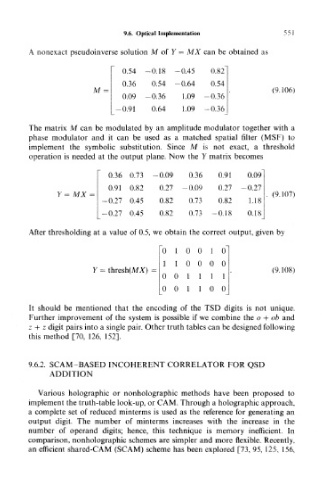Page 566 - Introduction to Information Optics
P. 566
9.6. Optical Implementation 551
A nonexact pseudoinverse solution M of y = MX can be obtained as
0.54 -0.18 -0.45 0.82
0.36 0.54 -0.64 0.54
(9.106)
0.09 -0.36 1.09 -0.36
-0.91 0.64 1.09 -0.36
The matrix M can be modulated by an amplitude modulator together with a
phase modulator and it can be used as a matched spatial filter (MSF) to
implement the symbolic substitution. Since M is not exact, a threshold
operation is needed at the output plane. Now the Y matrix becomes
0.36 0.73 -0.09 0.36 0.91 0.09~
0.91 0.82 0.27 -0.09 0.27 -0.27
y = MX = . (9.107)
-0.27 0.45 0.82 0.73 0.82 1.18
-0.27 0.45 0.82 0.73 -0.18 0.18
After thresholding at a value of 0.5, we obtain the correct output, given by
0 1 001 0
1 1 000 0
= thresh(M^) = (9.108)
0 0 1 1 1 1
0 0 110 0
It should be mentioned that the encoding of the TSD digits is not unique.
Further improvement of the system is possible if we combine the o + oh and
z + z digit pairs into a single pair. Other truth tables can be designed following
this method [70, 126, 152].
9.6.2. SCAM-BASED INCOHERENT CORRELATOR FOR QSD
ADDITION
Various holographic or nonholographic methods have been proposed to
implement the truth-table look-up, or CAM. Through a holographic approach,
a complete set of reduced minterms is used as the reference for generating an
output digit. The number of minterms increases with the increase in the
number of operand digits; hence, this technique is memory inefficient. In
comparison, nonholographic schemes are simpler and more flexible. Recently,
an efficient shared-CAM (SCAM) scheme has been explored [73, 95, 125, 156,

